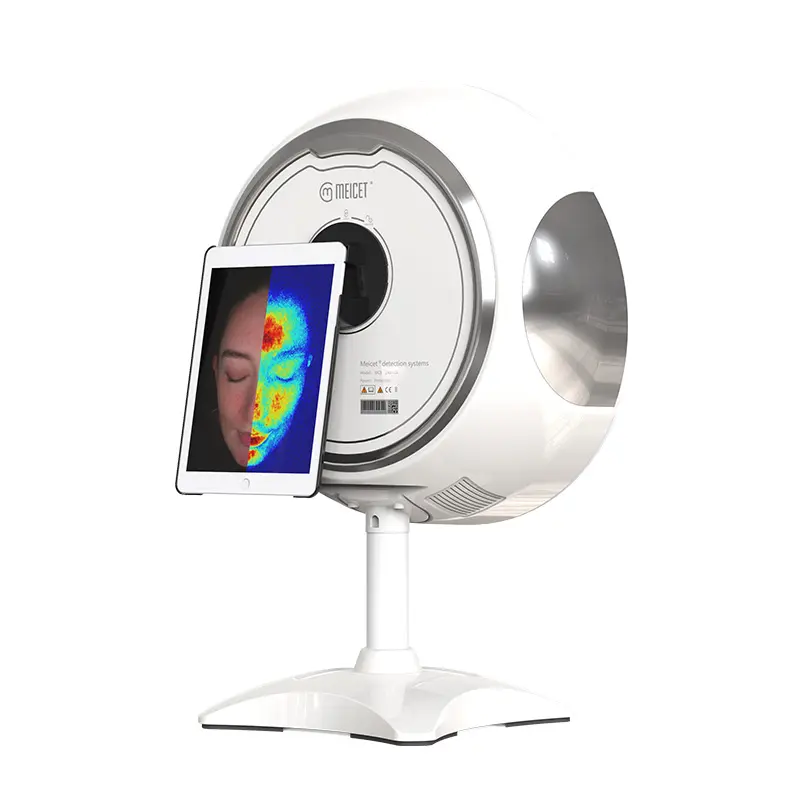
Topical anti-aging products—from retinoids and vitamin C to peptides and growth factors—are foundational to maintaining youthful skin, but their efficacy depends on consistent use and proper formulation. For patients, particularly those with busy lifestyles or complex regimens, adherence can suffer if they don’t perceive results, while clinicians struggle to objectively assess whether a product is working or needs adjustment. MEICET’s MC10 Portable Skin Analyzer addresses this by providing objective evidence of topical efficacy, even in remote settings, reinforcing adherence and guiding personalized adjustments to anti-aging regimens.

Quantifying Subtle Texture and Pigment Changes
Anti-aging topicals work gradually, with changes in wrinkle depth, texture, and radiance often taking time to become visible to the naked eye. The MC10’s imaging captures these subtle shifts, providing tangible proof of efficacy:
- RGB imaging tracks wrinkle morphology, showing how retinoids or peptides gradually soften fine lines. A patient using a retinol serum may have later MC10 scans showing “valleys” (wrinkles) becoming shallower and less defined in RGB mode—confirming collagen stimulation, even if the patient hasn’t noticed visible changes.
- UV imaging monitors vitamin C’s brightening effects by detecting reduced melanin fluorescence. Solar lentigines or post-inflammatory pigment appear as bright spots in UV mode; consistent vitamin C use leads to gradual dimming of these spots, with later scans showing reduced intensity—evidence of inhibited melanin production.
- Polarized light imaging assesses skin tightness, a marker of collagen and elastin improvement. Peptides or growth factors that stimulate fibroblasts lead to increased dermal density, reducing vascular visibility in polarized mode. A patient using a copper peptide serum may have later scans showing less redness in polarized light—indicating tighter, healthier skin.
Consider a patient using a combination of retinol (night) and vitamin C (morning) for photoaging, with regular MC10 scans at a community pharmacy:
- After some time: RGB shows subtle wrinkle softening, UV no change, polarized light minimal improvement.
- Later: RGB confirms shallower wrinkles, UV shows reduced pigment fluorescence, polarized light redness reduced.
- Much later: RGB significant improvement in wrinkles, UV reduced pigment, polarized light less redness—objective evidence the regimen is working.
This data reinforces the patient’s commitment, as they can visualize progress even when changes are subtle.
Identifying Product Tolerance and Adjustment Needs
Not all topicals work for all patients, and sensitivity can develop over time. The MC10’s imaging detects signs of intolerance, enabling timely adjustments:
- Polarized light redness beyond mild, transient irritation (e.g., retinoid “purge”) signals overuse or incompatibility. A patient with persistent redness in polarized mode while using a retinol may need to reduce frequency or switch to a lower concentration.
- UV barrier irregularities indicate a topical is disrupting the stratum corneum. A patient using a high-concentration AHA may have later UV scans showing increased patchiness—signaling the need to dilute the product or switch to a gentler exfoliant (e.g., PHA).
- RGB texture changes like peeling or scaling suggest excessive dryness, common with retinoids or AHAs. This finding guides the addition of a hydrating serum or occlusive moisturizer to support the barrier.
A patient with sensitive skin using a new vitamin C serum reports mild stinging:
- MC10 scans later show polarized light redness (mild irritation) and UV barrier irregularity.
- The clinician recommends switching to a buffered vitamin C formula and adding a ceramide moisturizer.
- Later follow-up scans show reduced redness and improved UV uniformity—tolerance restored.
Personalizing Regimens Based on Response
Skin responds differently to topicals based on factors like age, genetics, and environmental exposure. The MC10’s data enables personalized refinements:
- Patients with poor response to a topical (e.g., minimal wrinkle improvement on RGB later) may need a higher concentration or alternative ingredient (e.g., switching from retinol to tretinoin).
- Those with excellent response (significant pigment reduction on UV) can maintain the regimen, with MC10 scans confirming when to transition to maintenance (e.g., reducing retinol frequency).
- Patients with seasonal variations (e.g., worsened barrier function in winter) can have regimens adjusted based on UV scans—adding richer moisturizers or reducing actives during cold months.
A patient with mature skin using a peptide serum shows minimal RGB wrinkle improvement later. The clinician, guided by MC10 data, adds a low-concentration retinol to the regimen—resulting in better wrinkle reduction later.
The MC10 Portable Skin Analyzer transforms topical anti-aging from a passive endeavor to an active, data-driven process. By measuring subtle changes, identifying tolerance issues, and guiding personalization, it ensures patients get the most from their regimens while reinforcing adherence—ultimately delivering better, more consistent anti-aging results.
 EN
EN
 AR
AR
 BG
BG
 HR
HR
 CS
CS
 DA
DA
 NL
NL
 FI
FI
 FR
FR
 DE
DE
 EL
EL
 HI
HI
 IT
IT
 JA
JA
 KO
KO
 NO
NO
 PL
PL
 PT
PT
 RO
RO
 RU
RU
 ES
ES
 SV
SV
 TL
TL
 IW
IW
 ID
ID
 SR
SR
 SK
SK
 SL
SL
 UK
UK
 VI
VI
 SQ
SQ
 HU
HU
 TH
TH
 TR
TR
 FA
FA
 AF
AF
 MS
MS
 UR
UR
 BN
BN
 LA
LA

